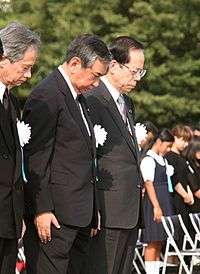Hiroshima Peace Memorial Ceremony
Hiroshima Peace Memorial Ceremony is an annual Japanese vigil.
Every August 6, "A-Bomb Day", the city of Hiroshima holds the Peace Memorial Ceremony to console the victims of the atomic bombs and to pray for the realization of lasting world peace. The ceremony is held in front of the Memorial Cenotaph in the Hiroshima Peace Memorial Park. Participants include the families of the deceased and people from all over the world. The first ceremony was held in 1947 by the then Hiroshima Mayor Shinzo Hamai.
In 2010, John V. Roos became the first United States ambassador to Japan to attend the ceremony, paving the way for a historic visit to Hiroshima by then President Barack Obama six years later.[1]
Contents of the ceremony

- Dedication of Water (by the citizen representatives of Hiroshima), accompanied (since 1975) by the music "Prayer Music No. 1: Dirge" by Hibakusha[2] composer Masaru Kawasaki[3][4]
- Opening
- Dedication of the Register of the Names of the Fallen Atomic Bomb Victims
- Address
- Dedication of flowers
- Silent Prayer and Peace Bell (for one minute from 8:15am)
- The bell is rung by one representative of bereaved families and one representative of children
- Peace Declaration (by Mayor of Hiroshima)
- Release of Doves
- Commitment to Peace (by Children's representatives)
- Addresses (by Prime Minister of Japan and other visitors)
- Hiroshima Peace Song, with music by Minoru Yamamoto and lyrics by Yoshio Shigezono
- Closing
Memorial ceremonies for Hiroshima outside Japan
Due to the dissemination of the memorial culture surrounding Hiroshima worldwide, memorial ceremonies were and are being held also in other parts of the world. One such instance was on Aug. 6, 1986, as a delegation from Hiroshima of 18 individuals arrived at the Israeli Holocaust memorial of Yad Vashem and held a brief ceremony at the Yizkor Hall.[5]
References
- Fackler, Martin (August 6, 2010). "For First Time, U.S. Envoy Attends Ceremony at Hiroshima". The New York Times. Retrieved August 18, 2019.
- "神奈川・川崎優さん〈核といのちを考える 遺す〉". 朝日新聞デジタル.
- "Composer continues to honor victims of Hiroshima". Colorado Springs Gazette.
- "Memories of Hiroshima and Nagasaki - The Asahi Shimbun". asahi.com.
- Ma'ariv (Israeli Hebrew daily), Aug. 7, 1986
External links
| Wikimedia Commons has media related to Hiroshima Peace Memorial Ceremony. |
- Hiroshima Peace Memorial Ceremony
- Peace Declarations
- Hiroshima Peace Camp 2011
- Hiroshima Peace Memorial Ceremony 2009
- Offering of water, 5,635 names added to the list of victims, making 263,945 in total
- Offering of flowers, minute's silence for the victims
- Peace Declaration by Mayor of Hiroshima
- Commitment to Peace by students
- Addresses by Prime Minister of Japan, by Governor of Hiroshima Prefecture
- by president of the United Nations General Assembly, by the Secretary-General of the United Nations
- Chorus of Hiroshima Peace Song
- Sheet music for Dirge and Peace Song